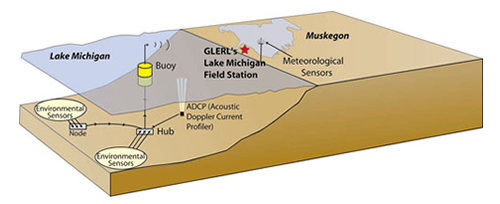 |
||||
Technology Development: Hardware Development
Marine Instrumentation Laboratory (MIL)
MIL's goal is to provide high quality instrumentation packages for oceanographic, biological, chemical, and water resources data collection. The highly skilled engineers and technicians of the Marine Instrumentation Laboratory (MIL) design electronics, develop schematics, manufacture circuit boards and develop computer software to support major systems design. MIL supports and maintains existing GLERL instrumentation, provides the hardware and software necessary for data acquisition systems, and provide various facility and ancillary support services.
Oceanography
The purpose of this equipment is the measurement of water currents, temperature, water quality parameters, wave conditions and the sampling of water and sediments for subsequent analysis.
 |
Focus on Current Measurements: MIL maintains a strong commitment to maintaining the current state of the art in this area. We currently maintain an inventoryconsisting of 8 RD ADCP's and several Sontek point current meters. We are currently also investigating the 3DACM current meter produced by Falmouth Scientific. MIL has also developed in house two series of satellite reporting Lagrangian drifters using Loran and GPS position sensing systems. Additionally MIL maintains a large active inventory of Vector Averaging Current Meters (VACM), Marsh-McBirney EM current meters and Neal Brown smart acoustic current meters (SACM). These aging systems are in the sunset phase of their utilization. |
 |
Autonomous CTD ProfilerThe ACP was programmed to mechanically drive a CTD package up and down a cable through 40 meters of the water column at the rate of once per hour, taking measurements at sub-meter intervals. The ACP uses an electric motor to drive the CTD package up and down a wire rope cable. Rubber end stops attached to the cable determine the limits of travel and can be adjusted to meet the specific requirements of the experiment. The operation of the ACP is controlled by an embedded microprocessor and data is stored onto a compact flash disk. The flexibility of the programmable data logger allows specifying the interval of the cycles as well as the sample rate. The unit can sample and record data from the sensors in intervals as small as 10 cm. (more) |
 |
Microcontrollers and Dataloggers Recent advances in electronics have produced very small and economical computer driven controllers. These powerful tools have made it possible for instrument developers to design powerful measurement platforms with a minimum investment of time and capital. Shown at left is the controller developed recently for the MIL programmable sequential sediment sampler. |
 |
Lagrangian Drifters An important area of work for MIL has been the design and development of drifting current measurement systems. At left is an example of an MIL designed drifter which used the GPS system to report locations to the ARGOS series satellites. This unit is controlled with a Tattletale 2B datalogger. Currently we have 11 of these units in inventory. These units were produced significantly in advance of the availability of similar commercial units. |
 |
Sequential Sediment Samplers MIL has designed in house a programmable 24 bottle suspended sediment sampler. This instrument is currently in it's third version. Early examples utilized an entirely in house designed controller. The current version uses a Tattletale TFX-11 datalogger. Currently there 22 units in active use with 14 committed to the EEGLE project in FY99. Several of these instruments have been distributed both nationally and internationally.
|
 |
Plankton Survey System (PSS) The Plankton Survey System (PSS) was assembled by GLERL's Marine Instrumentation Lab (MIL) in 1997 to measure distribution and abundance of zooplankton, tiny waterborne crustaceans that serve as a food base for various species of larval fish. It measures turbidity, chlorophyll a, photosynthetically active radiation (PAR), conductivity, temperature, and zooplankton distribution. The PSS and its onboard instruments has been successfully used on an ongoing basis to survey physical, chemical and biological conditions before, during and after Lake Michigan sediment resuspension events as part of the 5-year Episodic Events Great Lakes Experiment (EEGLE) program. |
Meteorology
|
|
WebCams and Met Stations GLERL's Marine Instrumentation Laboratory has deployed and is maintaining a real-time network of shore-based meteorological instrument packages in Wisconsin, Michigan, Illinois, and Indiana. Stations in Illinois and Michigan also include web cameras. All meteorological observation stations measure and record wind speed, wind gust, wind direction, and air temperature. In addition, instruments in Chicago measure water levels, and instruments at Muskegon measure dew point, relative humidity, atmospheric pressure, and light level. This data as well as camera images are updated at 5-30 minute intervals and displayed on GLERL's web site.
|
 |
|
Lake Michigan Wireless Environmental Observatory MIL is developing the first environmental observatory using wireless internet technology on the Great Lakes at GLERL's Lake Michigan Field Station in Muskegon, MI. When fully developed, the observatory will provide chemical, physical and biological data to support long-term research on the Great Lakes. These data will be available to the scientific and educational community via the internet through real-time observations. The goal of this project is to put in place the infrastructure needed to simplify sensor deployment and data acquisition to allow information access by scientific researchers, educators and the public. This is an important contribution to GLERL's leadership in supporting and promoting observation system development among Great Lakes universities and non-governmental organizations. The environmental observatory consists of an offshore buoy connected to a hub that recieves data from various environmental sensors such as an acoustic doppler current profiler. The data are then sent through a wireless link to an onshore receiver connected to the internet. |
See also:
A brochure of Selected Projects of GLERL's Marine Instrumentation Lab (pdf format) is also available.
MIL Personnel Directory:
John C. Lane, ET 734-741-2347 John.Lane@noaa.gov
Terrence C. Miller,ET 734-741-2217 terry.miller@noaa.gov
Ronald W. Muzzi, EE 734-741-2007 Ron.Muzzi@noaa.gov
Steven A. Ruberg, EE, Head MIL 734-741-2271 Steve.Ruberg@noaa.gov
Alan F. Shrum, MH 734-741-2256 Alan.Shrum@noaa.gov
-
For more information, please contact:
Steve Ruberg, Head MIL
John Lane



